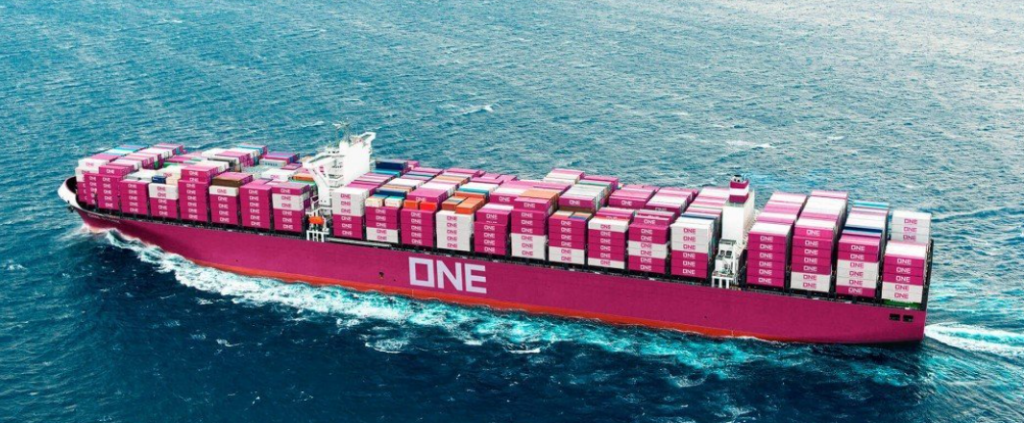Ocean Network Express (ONE), the world’s sixth largest container ship owner, has selected two Chinese shipyards to build a series of 13,000 TEU methanol dual-fuel neo-Panamax containerships, with a total order value of nearly US$2 billion (RMB 14.518 billion), and it is expected that the new ships will be delivered between the end of 2026 and 2027, according to Trade Winds.

It is reported that ONE has signed shipbuilding contracts with Jiangnan Shipbuilding, a subsidiary of CSSC, and China’s largest private shipbuilder Yangzijiang Shipbuilding Group, and the two shipyards will build six ships each.
Foreign media reported in early October that ONE will order 10+5 13,000 TEU-class neo-Panamax containerships. At then, some analysts said that ONE might choose HD Hyundai Heavy Industries and Nippon Shipbuilding, with which it had already cooperated several times, to place the order.In May 2022, HD Hyundai Heavy Industries and Nippon Shipbuilding split ONE’s order for 10 13,700 TEU containerships; in March 2023, ONE again ordered 10 13,700 TEU containerships from Nippon Shipbuilding for delivery in the period from 2025 to 2026. It is worth mentioning that both batches of new vessels are designed with ammonia/methanol fuel reservation and equipped with bow windwalls and other energy-saving technologies.
However, according to the latest news, Chinese shipyards finally stood out in this “order melee” and successfully bagged the large orders.
With global decarbonization accelerating and environmental regulations becoming more stringent, the shipping industry continues to transition to net-zero emissions, and methanol is increasingly being chosen by shipowners as the potential marine fuel of the future. Compared to traditional marine fuels, methanol can reduce sulfur oxide emissions by 99%, nitrogen oxide emissions by 60% and carbon dioxide emissions by 7%.
In April this year, Jiangnan Shipbuilding also contracted six 15,000 TEU methanol dual-fuel container ships from France CMA CGM Group. This type of ship adopts green methanol as the main fuel, which can realize net zero emission in the whole voyage and has completely independent intellectual property rights. The ship has an overall length of 366 meters, a beam of 51 meters, a depth of 30.2 meters, and is capable of transporting 156,000 tons of cargo. In June this year, Maersk ordered six 9,000 TEU methanol dual-fuel container ships from Yangzijiang Shipbuilding Group, which started the process of receiving orders for methanol-powered container ships of Yangzijiang Shipbuilding Group.
On October 31, ONE announced its Q2 FY2023 results (July to September) report, reporting operating income of US$3.549 billion, down 62% year-on-year; net income of US$187 million, down 97% year-on-year; and earnings before interest, taxes, depreciation, and amortization (EBITDA) of US$496 million, down 92% year-on-year. ONE expected full-year after-tax profit of $51 million, compared with $14.5 billion in 2022, showing a “precipitous” decline.
According to the company, the failure of a strong recovery in peak-season cargo volumes, the increase in newbuilding and the weak supply-demand balance, the “stagnant rates” on major East-West routes, the lack of sustainability of North America-bound shipments and low inflation in Europe did not contribute to a full recovery of cargo led to the decline in the quarter’s results.
Facing plummeting profits and an oversupplied container market, ONE has not given up on its newbuilding program, but has chosen to continue to expand its fleet.ONE has previously announced plans to invest up to $20 billion in ships, terminals, containers and IT systems by 2030: $10 billion will be used to build new ships (with newbuildings of up to 150,000 TEUs per year expected); and $10 billion will be used in the areas of areas such as terminals, containers and IT technology.
According to the data, ONE now has a fleet of 227 vessels with a capacity of 1,714,500 TEU, ranking sixth in the world, with a market share of 6.1%. Another 37 new ships are under construction, with a capacity of 497,200 TEU, and hand-held orders account for 29% of the current fleet.


